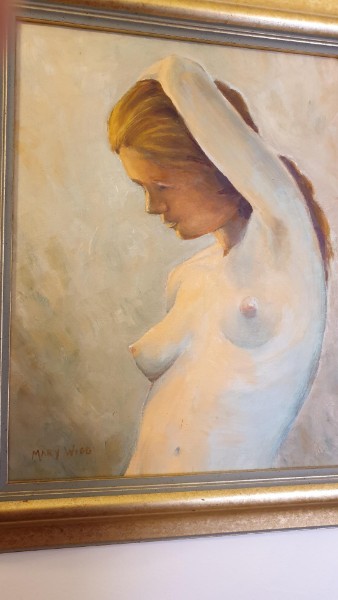Mary M. Wigg (nee Lamphee) – South Australian Artist 1940s – 1970s
Mary Millicent Lamphee was born at Kensington Park, South Australia, on 8 October 1904 to parents Phillip and Clara (nee Dunstan) Lamphee. Phillip was Manager of the English, Scottish & Australian Bank in Adelaide, an iconic well-respected financial institution.
Mary died in Adelaide on April 29 2001 aged 96 years. She was a South Australian artist active in the 1940s, 1950s and 1960s where she held several exhibitions including one at the Walkerville Gallery opened by Sir Henry Newland in September 1963 where her oil works featured two Sydney street scenes ‘Kings Cross’ and ‘Old houses, Pyrmont’ which art critics described as being drawn with assurance and clarity.
Other exhibitions followed in the Adelaide Festival of Arts - exhibition of Australian art, March 6-21, 1964 and a second exhibition at the Walkerville Gallery in 1967 where reviewers described her impressions as rather tight and air-less, painstakingly accurate, and becoming almost primitive in a piece titled ‘South Kensington.
Her work has been sold at auctions in South Australia. She is best known for her landscapes often undertaking trips to the Grampians in Victoria.
Her works are typically oil on board or acrylic on masonite and include diverse subjects such as Churches in well-known South Australian coastal locations like Goolwa.
Mary also painted South Australian coastal scenes such as Parsons Beach also known as Pareena beach, which lies immediately west of Waitpinga Hill head, and has stunning cliff top views of the 1.2 km long beach.
She married engineer and pilot Ronald Melrose Wigg M.E. on 20/6/1931 at St. Peter’s College Chapel, Hackney, South Australia when he was 35 and she was 26. He was the grandson of well-known businessman and stationer E.S. Wigg and they had three children.
Mary painted a Tidal Mill, built c. 1100 A.D., which was at Woodbridge, Suffolk on E.S. Wigg’s original farm. E.S. is said to have lost the top of his finger there! This picture is published in the book on the family history of E.S Wigg.
She went to Girton Girls School Adelaide and the Elder Conservatorium of Music. At Girton she met Jessamy Bruce, the woman whom Mary Wigg exhibited her paintings with in 1967. Jessamy and Mary also were of the same social set and went to the same dances.
She also played the and played the viola in the Adelaide Symphony Orchestra.
Mary Wigg is one of Australia’s unrecognised female artists. Never collected by institutional galleries, she would have been classified by the mostly male dominated cultural elite at the time as an amateur and hobbyist not worthy of collecting by publicly funded institutions.
Coming from an upper-class, moneyed Adelaide family, she would have been classed as a part-timer whose art was merely a past-time of the rich and idle. This view would have been reinforced by social norms at the time and she would have struggled to have been taken seriously by the art community at the time.
Yet her work is far from this. Her landscapes are rich and well composed. They capture the essence of what it means to be Australian.
Her nude, speculated to be a self-portrait, and one of her early works while still at art school is particularly significant and stunning.
Mary Wigg is a great example of the hidden talents of Australian woman artists whose body of work has largely been invisible to the Australian art world.
Six oil paintings by Mary M. Wigg are held in the Fairview Art Collection.





